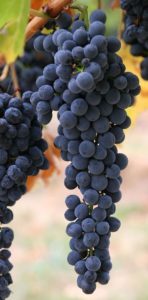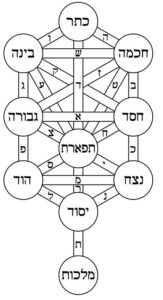Who was Og and how did he survive the Great Flood? What exactly were the Ten Trials of Abraham?What is the difference between Chokhmah, Binah, and Da’at (“Chabad”)? Which of the “Cosmic Shemittot” are we in? Where was the Garden of Eden? Find out the answers to these and other big questions in Sefer Beresheet:
Tag Archives: Tree of Knowledge
Why Kiddush on Wine?
 In this week’s parasha, Nasso, the Torah commands that a nazir is to abstain from wine and any other grape products. Wine appears frequently in the Torah, and plays a huge role in Judaism. Every Shabbat and holiday is ushered in with kiddush on wine, and concludes with a wine havdallah. Every wedding has a blessing on wine under the chuppah, as does a brit milah, and in ancient times wine libations were brought in the Temple. What makes wine so special?
In this week’s parasha, Nasso, the Torah commands that a nazir is to abstain from wine and any other grape products. Wine appears frequently in the Torah, and plays a huge role in Judaism. Every Shabbat and holiday is ushered in with kiddush on wine, and concludes with a wine havdallah. Every wedding has a blessing on wine under the chuppah, as does a brit milah, and in ancient times wine libations were brought in the Temple. What makes wine so special?
The numerical value of “wine” (יין) is 70, a most significant number. It reminds us of the seventy names of God, of the seventy root nations of the world, and the seventy “faces” of Torah understanding. Our Sages famously stated that nichnas yayin, yatza sod, “when wine enters, secrets come out”. More than a simple proverb, it is a mathematical equation since the value of “secret” (סוד) is also 70. So, as seventy comes in, seventy comes out. On the surface level, the statement means that alcohol makes a person more likely to spill their secrets. On the deeper level, though, the Sages meant that one who drinks wine may be able to enter a mental state where they can uncover the secrets of Torah, and see it through all seventy faces. Wine can make “a man’s mind more receptive” (Yoma 76a).
Our Sages taught that wine is unique in that it defies the natural order: whereas other things degrade over time (as encapsulated in the second law of thermodynamics, the law of entropy, that the universe always tends towards disorder), wine improves and gets more valuable over time. Wine has another incredible scientific quirk: Japanese scientists researching electrical superconductors had a party in their lab and ended up accidentally discovering that wine makes certain metals superconductive!
Superconductivity refers to the property of being able to transmit electricity perfectly with no resistance and no energy loss. Generally, superconductivity requires cooling substances to near absolute zero (-273ºC). Some substances are able to superconduct at higher temperatures, around -90ºC, but even this is far too cold to be practical. Scientists around the world are therefore on the hunt for a room-temperature superconductor which, if found, would completely revolutionize the world. It would result in dramatic energy savings, and would allow for other cool phenomena like “quantum levitation”.
The Japanese scientists found that wine makes some things superconductive, especially iron-based compounds. And red wine especially was up to seven times more effective than other alcoholic beverages. No explanation for this has yet been found. It is all the more significant when we consider the central role that electricity plays in Jewish mysticism, and that our brains literally run on electrical signalling (suggesting how wine might make our brains more receptive to Torah secrets!) and that our bodies are full of iron, which makes our blood red, too.
While all of the above is fascinating, it does not explain why wine is so prevalent in Jewish rituals, especially in the recitation of every kiddush. What is the reason for wine? Continue reading
A Mystical Peek Into Megillat Esther
Purim is a deeply mystical holiday. In fact, Megillat Esther literally means “revealing the hidden”. While God is not explicitly mentioned anywhere in the Scroll, His fingerprints can be found all over it. In the same way, the Megillah is imbued with tremendous hidden wisdom. That it has a total of 10 chapters is the first clue, and if you read carefully, you will find that just about every Sefirah is mentioned!
 The first Sefirah is Keter, the great “Crown” of God, and the first chapter of the Megillah is all about highlighting the greatness of Achashverosh’s crown and kingdom. Our Sages taught that Achashverosh wished to dress in the vestments of the kohen gadol, to “crown” himself as a king of the Jews (Megillah 12a). As is well-known, it was also taught that every time the Megillah refers to “the king” without a name, it is secretly referring to the King, to God. In Kabbalah, Keter always refers to Willpower (Ratzon), since the starting point of any endeavour is the will to do it. Everything begins with a will, and the universe began with God’s Will to create it, setting all of history in motion. Similarly, in the first chapter of the Megillah we find that Queen Vashti refuses to do the will of Achashverosh, thus setting the whole Purim story in motion.
The first Sefirah is Keter, the great “Crown” of God, and the first chapter of the Megillah is all about highlighting the greatness of Achashverosh’s crown and kingdom. Our Sages taught that Achashverosh wished to dress in the vestments of the kohen gadol, to “crown” himself as a king of the Jews (Megillah 12a). As is well-known, it was also taught that every time the Megillah refers to “the king” without a name, it is secretly referring to the King, to God. In Kabbalah, Keter always refers to Willpower (Ratzon), since the starting point of any endeavour is the will to do it. Everything begins with a will, and the universe began with God’s Will to create it, setting all of history in motion. Similarly, in the first chapter of the Megillah we find that Queen Vashti refuses to do the will of Achashverosh, thus setting the whole Purim story in motion.
The second Sefirah is Chokhmah, and the second chapter begins by introducing us to Mordechai, the paragon of a chakham, a Jewish sage. In Kabbalah, Chokhmah is also called Abba, the “father”, and we are told that Mordechai plays the role of an adopted father for the orphaned Esther. The third Sefirah is Binah, and the third chapter begins by introducing Haman, a master manipulator who knew how to twist people’s binah, “understanding”. Our Sages asked (Chullin 139b): where is Haman alluded to in the Torah? They answered that he is found in the words hamin ha’etz, “from the Tree”, referring to the Tree of Knowledge in the Garden of Eden (Genesis 3:11) Our Sages associate Haman with the Tree of Knowledge, the consumption of which brought evil into the world. According to one Kabbalistic view, the Tree of Life is associated with Chokhmah, while the Tree of Knowledge is associated with Binah, hence the mystical connection to Haman. It goes deeper. Continue reading
